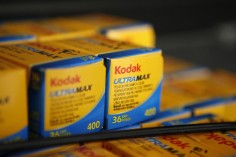
Snappier outlook
Former film giant Kodak is seeking to recapture its moments through printing, a US$600 billion global market which offers bright prospects
Kodak, the one-time film giant and inventor of the digital camera that emerged from bankruptcy protection in September, has been reincarnated as a commercial and digital printing company focused on Asia and China.

"The filing of bankruptcy protection in January 2012 was not an easy choice but a very necessary one as it gave time for us to go through the restructuring process to sell out of non-core assets and businesses," Matteucci said. "We are now a much leaner but a more cost-effective and profitable company."
The 134-year-old firm had its glory days in the past century but Kodak's moment has come and gone. The company that ruled the world of film photography for more than a century survived two world wars, numerous financial crises and keen competition from Japanese film and camera makers in the 1980s. But it was not able to withstand a more recent shift to picture taking on smartphones and digital cameras, with people no longer needing its flagship film products.

Matteucci said the restructuring meant Kodak was no longer a film and camera company. It sold the photo and film business to its former employees and has also stopped selling inkjet printers. It no longer makes its own cameras, but the brand lives on on new fixed-lens digital cameras made by US company JK Imaging under a licensing agreement.
Its last remaining film business provides films for motion pictures and represents about 10 per cent of its business. The rest of the new Kodak business, as Matteucci is now busy telling everybody, is focused on commercial printing and packaging printing for corporate clients. This includes printing newspapers, books, company brochures and packages.
"Printing is a very big business with bright prospects," he said. "Globally, the printing business is valued at US$600 billion, which is bigger than the car business at US$400 billion."
He said printing needed the high-quality imaging that Kodak's technology could provide, ranging from digital printing for smartphones to helping newspapers achieve high-speed printing with flexible advertisement options. For book printing, it could print any number on demand.
The new Kodak is much smaller. It predicts this year's revenue will be US$2.5 billion, only a quarter of its revenue five years ago. Its now employs 8,500 staff, down from about 10,000 when it went into bankruptcy and a peak of 145,300 in 1988.
The restructuring has, however, helped it return to the black, delivering a third-quarter operating profit of US$3 million, compared with a US$23 million loss in the same quarter last year. Its debt fell to US$679 million from US$1.4 billion at the end of last year.
"We are smaller but we are now in a good shape and have a more viable business model," Matteucci said, adding that Kodak was on track to make a gross profit of US$505 million this year.
Kodak now has a third of business in Asia, with the rest in the US, Europe and Latin America. Matteucci said he was optimistic about growth in Asia, particularly China, where it has 1,200 staff and has printed newspapers.
"China is a very important market for Kodak. With its huge population and increasing middle class, it is going to have an increasing demand for packaging printing and other commercial printing," he said.
Package printing in China is estimated to be valued at 632 billion yuan (HK$803 billion) a year, with an annual growth rate of about 20.5 per cent.
"The new Kodak business is still related to everybody's life," Matteucci. "We are printing for packages for goods that people buy at the supermarkets. We also print the books and newspapers they read every day."
Kodak played a role in almost everyone's life in the 20th century. The company, founded by US entrepreneur George Eastman in 1880, marketed the world's first flexible roll film in 1888, enabling people to record their memories and reporters to capture historical moments.
It also invented the first digital camera in the 1970s, a technological breakthrough that ironically killed the roll film business.
"The lesson we learn from the past is that we need to react to technological change promptly," Matteucci said. "When people use digital more, we need to react to it in a dynamic way. The new Kodak is no longer a photo company but we are a technology one that is ready to provide high-quality printing and other digital solutions for our customers."

